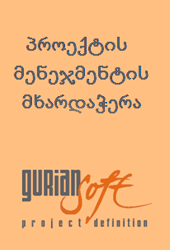Georgians
 Modern territory of Georgia and its east-west lands were settled with congener Georgian tribes from ancient times. Georgian people were formed thousands of years ago as a result of their enduring inter-communication and inter-embodiment. The Georgians belong to the Iberian-Caucasian people with their language. Megrelian (Zanian) and Svanian languages, that make Georgian lingual group, took part in the formation of modern Georgian language together with the old Georgian language. Kolkheti and Iberia-Georgian states that were founded in VIII-VII and IV-III B.C. (before Christ)--had great role in the unification of congener tribes. We must reckon with the fact that origination of the East-Georgian State Daiaeni also existed in XII-VIII centuries B.C. Political consolidation precipitated development of material and mental culture and formation of the Georgian nation. Recognition of Christianity as the state religion (IV century), establishment of the Georgian Christian writing and lately creation of the unified feudal state by unification of all Georgian kingdoms and princedoms (X century), greatly contributed to the formation of the Georgian nation.
Modern territory of Georgia and its east-west lands were settled with congener Georgian tribes from ancient times. Georgian people were formed thousands of years ago as a result of their enduring inter-communication and inter-embodiment. The Georgians belong to the Iberian-Caucasian people with their language. Megrelian (Zanian) and Svanian languages, that make Georgian lingual group, took part in the formation of modern Georgian language together with the old Georgian language. Kolkheti and Iberia-Georgian states that were founded in VIII-VII and IV-III B.C. (before Christ)--had great role in the unification of congener tribes. We must reckon with the fact that origination of the East-Georgian State Daiaeni also existed in XII-VIII centuries B.C. Political consolidation precipitated development of material and mental culture and formation of the Georgian nation. Recognition of Christianity as the state religion (IV century), establishment of the Georgian Christian writing and lately creation of the unified feudal state by unification of all Georgian kingdoms and princedoms (X century), greatly contributed to the formation of the Georgian nation.
In connection with fact that there is immediate, i.e. direct source about numeration of the Georgian people for old epoch, two principal assumptions, based on various non-direct data, are expressed in a series of historical investigations. First one is based on the following fact: Georgians, according to the calculation of Mongols, had to call of 90 thousand persons in the army in mid years of XIII century, because they were obliged to call of only one warrior for 9 families of full might. According to this hypothesis, 5 million persons determine population of Georgia of that time. Second assumption is based on the data of the same Mongols about calling of Georgians in the army, but twice twice fewer indicators determine population of Georgia of that time.
Heavy political and social-economic conditions, created from the second quarter of XIII century, lasted during centuries and caused gradual and from time to time catastrophic diminution of the population. Sufficiently unprofitable demographic situation was created in the first half of XVIII century too, when attacks of aggressive Persian forces and internal disorders produced large number of victims and devastation of series of south provinces. Diminution of absolute numeration of population lasted till the seventies of XVIII century. Georgian population was decreased to the minimum by that time and did not exceed 750-770 thousand (in modern borders), this was just 0,08% of the world`s whole population. Heavy political and economical conditions of the late mid centuries did not restrain only future development of material and mental culture of the Georgian nation, but created real danger to the physical existence of the nation.

In spite of the fact that absolute number of the Georgian population increased in XIX century, gradual decrease in partial number of principal indigenous residents still took place, because settlement of non-Georgian nationalities strengthened in the same period in Georgian towns and villages. Even worse situation was created in the first half of our century on this side, first-massive settlement of Armenians in 900 and after that-excessive colonization of foreign people and new, sharp decrease in partial number of Georgians. Despite fact that natural increase of our principal population was on high level, only 61,4% of the resident of whole republic came on Georgians. Neither then not after, general registrations of the population did not determine such diminutive specific weight of Georgians in the whole population.
Middle years of the past century stand as peculiar crucial period in dynamics of partial number of the Georgian population: if specific weight of Georgians was decreasing during century and a half, lately ethnic strength of population changes in opposite direction-partial number of Georgians raises (see the table).
90 years were needed to double amount of Georgians in the Georgian modern borders from the beginning of XIX century. Last doubling lasted during 60 years in XX century (1930-1990). If we express in other words, number of Georgians increased one and a half times faster then in previous century; and this process took place when two world wars and bloody repressions of twenties and thirties hampered increase of numeration of our nation during XX century. Numeration of Georgians, in frames of nowadays Georgia, increased by 6.2 during whole 190 years (1800-1990). Whole population of Georgia increased by 5.7 (i.e. from 952 million to 5,4 milliard) in the same period.
Numeration dynamics of Georgians in Georgia, in 1800-2002 years
Years Number of the Georgian population
(By thousands) Specific weight in the whole population
(%)
1800---- 622,6 thousands ----79,4 %
1832---- 677,1thousands ----75,9 %
1865---- 950,6 thousands----73,8 %
1886---- 1188,1thousands---- 72,4 %
1897---- 1331,3 thousands ----69,4 %
1926---- 1788,2 thousands ----66,8 %
1939 ----2173,6 thousands ----61,4 %
1959---- 2600,6 thousands ----64,3 %
1970---- 3130,7 thousands ----66,8 %
1979---- 3433,0 thousands ----68,8 %
1989---- 3787,4 thousands ----70,1 %
2002 ----3661,1 thousands---- 83,8 %
 We must mention that number of Georgians, from the beginning of XIX century-during 140 years, was increasing in faster rate in Georgia than whole population of the world. Nevertheless, we have contradictory situation during last half century, this is caused because of our great looses in the second world war, laggard increase of Georgians and fast growth of average population of the whole world in post-war period. We must say generally that growth of Georgians during190 years was more equal comparing to the world`s population. In Georgians and in the whole population of Georgia, if we do not consider Azerbaijanians and Kurds living in our republic, was not expressed that "population explosion", which took place in the world in the second half of XX century (mainly in developing countries).
We must mention that number of Georgians, from the beginning of XIX century-during 140 years, was increasing in faster rate in Georgia than whole population of the world. Nevertheless, we have contradictory situation during last half century, this is caused because of our great looses in the second world war, laggard increase of Georgians and fast growth of average population of the whole world in post-war period. We must say generally that growth of Georgians during190 years was more equal comparing to the world`s population. In Georgians and in the whole population of Georgia, if we do not consider Azerbaijanians and Kurds living in our republic, was not expressed that "population explosion", which took place in the world in the second half of XX century (mainly in developing countries).
External migration procedures have important influence on numeration dynamics of the whole population of Georgia, but their role is relatively unimportant in changes of amount of itself Georgians. Natural growth is decisive in increase of Georgians, because number of gone people exceeds number of comers. As for the non-Georgian population, external migrations before the second world war contributed to the growth of their principal part, but situation diametrically changed in fifties: more people from non-Georgian population go than come, i.e. mechanical relocation decreases their growth rate.
First and second world wars` negative influence on the growth of Georgian nation is clearly seen in the table. The lowest growth of Georgians takes place in that historical moment which comprises years of war-if we do not consider first third of the previous century, when contributing conditions for the growth of population were not created yet. As for other historical periods, rate of average annual growth of Georgians stands close to the natural increase. The 1970-80s are exclusions from this point of view, when actual growth noticeably exceeds natural growth of Georgians. We must take into consideration the following circumstances: natural assimilation of the one part of Georgians took place with Georgians; many Georgians accepted Gregorian faith in XVIII-XIX and were registering as Armenians. Some part of them reestablished their nationality in the last years.
Georgians are gathered in their own homeland more than any other nations comparing to the principal nationalities of previous Soviet Union. 95,1% of Georgians, living in the whole Soviet Union, was settled in Georgia in 1989. Beginning from thirties, number of Georgians was increasing much more rapidly in other republics than in Georgia.

Number of Georgians increased by 2,1 in Georgia in 1926-1989 years and in other republics of previous soviet union by 5,8. This takes place when part of Georgians experiences assimilation; i. e. changes its national belonging. It is evident, that Georgians were going to other republics in mentioned years. Tens of thousand Georgians went to other republics during the last years. Number of gone people before war was relatively small, it gradually grew in post-war period and reached maximum in seventies and eighties. Georgians, in the villages of neighbor republics, lived compactly on the territory of Azerbaijan-Saingilo, also in the village Plastunka-near Sotchi. Saingilo is the former territory of west Kakheti and Ingilos are local native residents, as for Plastunka, Georgians settled there by the end of XIX century. Much more Georgians live out the borders of republic, in cities of previous Soviet Union, than in villages. Sufficiently big colonies of Georgians are in cities of north Caucasus-Vladikavkaz, Nalchik and Kislovodsk. Mokhevians (people from ravine) started to settle in Vladikavkaz in the second part of XIX century, Georgians from zemo Ratcha (upper Ratcha) also settled in two other towns long time ago.
According to the data of 1989, most number of Georgians (by thousands), out of frames of Georgia, lives in the following republics of the previous soviet union: Russian Federation- 130,7; Ukraine- 23, 5; Azerbaijan- 14,2; Kazakhstan- 9,5; Uzbekistan- 4,7; Byelorussia- 2,8. Approximately thousand Georgians live in each of other republics. Many Georgians are in Moscow, Petersburg, Kiev, Kharkov, also in towns of Donbas and Ural. Intelligentsia and students exceeded other Georgian residents in above-mentioned towns up to last time. Departure of Georgians in Russia and some other countries especially strengthened from 1991 up today.
Out of borders of the previous Soviet Union, Georgians compactly live in Turkey and Iran. Georgian provinces, located on southwest of nowadays Georgia, were settled with Georgians from ancient times. These provinces are: Tao-Klarjethi, Shavshethi, Artanuji, Kola, Basiani and other. Georgian people accepted Muslim forcedly from XVI century, after Turks had conquered mentioned provinces. Important part of Georgians was settled in other places afterwards. Because of this, most of the Georgian population experienced assimilation with Turks and lost mother language. In spite of all this, part of Georgian sustained Georgian language, character and habits in Turkey up today. Lazians, people of Georgian race, live on the territory of Turkey, in sea-front line of the Black sea that borders about Georgia. According to the several data, their number in the middle years of past century reached 300 thousand.
 Sufficiently large territory of settlement of the Georgian population in Turkey represents spreading area of Georgian material and mental culture. Distinguished monuments of classic period of the Georgian architecture remain up today: temples-Khakhuli, Opiza, Oshki, Bana and other. Also ruins of castles and bridges. In connection with fact that many Georgians settled in west Anatolia during years of the First World War and in period after war, Georgian settlement appeared in areas of Bursi, Sinopi and other towns.
Sufficiently large territory of settlement of the Georgian population in Turkey represents spreading area of Georgian material and mental culture. Distinguished monuments of classic period of the Georgian architecture remain up today: temples-Khakhuli, Opiza, Oshki, Bana and other. Also ruins of castles and bridges. In connection with fact that many Georgians settled in west Anatolia during years of the First World War and in period after war, Georgian settlement appeared in areas of Bursi, Sinopi and other towns.
Georgians exceeded 10 thousand before the Second World War in Iran, only in the province of Phereidan. Georgians also lived in the provinces of Iran-villages of Gilian, Mazanderan and Azerbaijan. Many Phereidanian Georgians settled in the towns of Iran in post-war period, among them in Teheran (some families arrived in Georgia).
Georgians, refugees from the homeland, created colony in France in 1921. Young emigrants, who left motherland with aim to study or because of political motives, joined them in next years.
Georgian soldiers, captives of war during years of the Second World War, were thrown to many countries of the west Europe. Many of them fought against fascist Germany in partisan detachments. It is known fact how more than 500 Georgian captive-soldiers died because of the rebellion against Germans (on the island Texel of Holland in summer of 1945).
Part of Georgians settled in America from Europe in the post-war period. In connection with, that there are no compact settlements of our compatriots in the countries of Europe and America, assimilation with local people is awaited for those residents of Georgia who live there.

Political consolidation and forming of the Georgian nation also meant joining of the separate parts of country in the epoch of developed feudalism. Historical-geographic provinces, existed from ancient times, still sustained traditionally established ethnographical characteristics; this was expressed in many elements of material and mental culture. Historical-geographic provinces continue to exist nowadays too, but differences between them are diminished to minimum because of the following reason: in modern epoch-when mobility of the population strengthened, urbanization reached many spheres of live, educational, cultural and scientific activities developed, ethnographical characteristics of the separate regions now stand on equal basis. Today, all existing historical- geographical provinces are constituent parts of unique national body and their common signs are expressed much more mightily then living or other characteristics of ethnographical groups.
Sources:
-P. Gugushvili, Economic development of Georgia and Caucasus in XIX-XX centuries. B.#1, Tbilisi, 1949, pages-456-611;
-At the origins of State system, Tbilisi 2001 (materials of scientific discussion).
-V. Jaoshvili, Population of Georgia in XVIII-XX centuries, Tbilisi, 1984;
-V. Jaoshvili, Population of Georgia, Tbilisi, 1996, pages-297-305;
- Principal results of census of the Georgian population, Tbilisi 2002, vs. I-II.
Georgians






